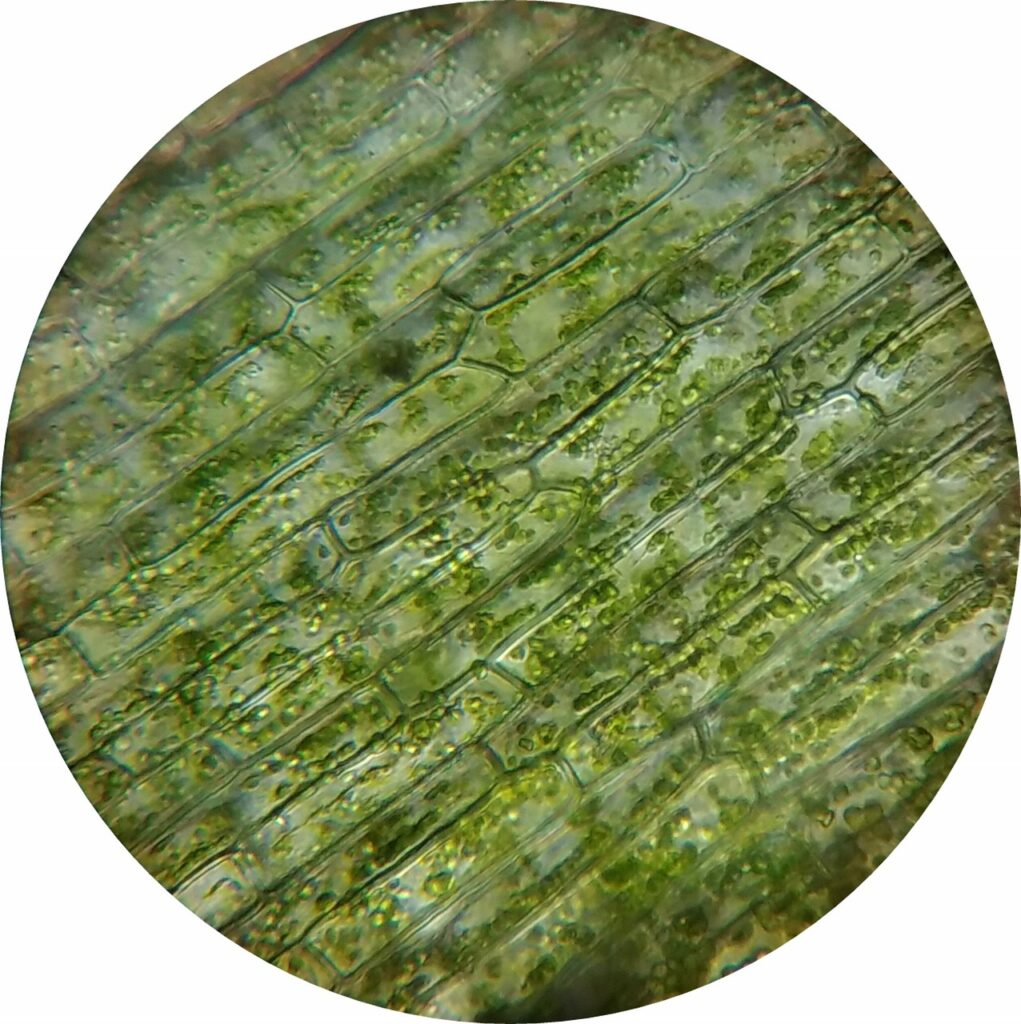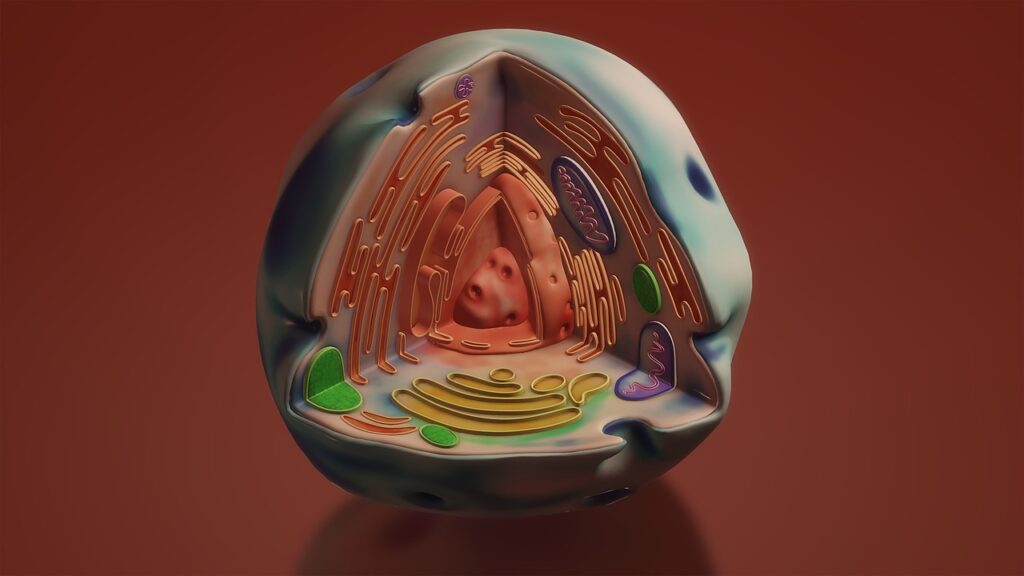1. Which of the following is the powerhouse of the cell?
(a) Nucleus
(b) Mitochondria
(c) Ribosome
(d) Lysosome
Answer: (b) Mitochondria
Explanation: Mitochondria is known as the powerhouse of the cell because they generate ATP, through cellular respiration.
2. The organelle responsible for photosynthesis in plants is:
(a) Mitochondria
(b) Chloroplast
(c) Golgi apparatus
(d) Endoplasmic reticulum
Answer: (b) Chloroplast
Explanation: Chloroplasts contain chlorophyll, which captures light energy to convert carbon dioxide and water into glucose during photosynthesis.
3. Which structure is known as the control center of the cell?
(a) Mitochondria
(b) Nucleus
(c) Ribosome
(d) Endoplasmic reticulum
Answer: (b) Nucleus
Explanation: Nucleus contains genetic material (DNA) that controls the cell’s activities and regulates gene expression.
4. The lipid bilayer of the plasma membrane is primarily composed of:
(a) Proteins
(b) Phospholipids
(c) Carbohydrates
(d) Cholesterol
Answer: (b) Phospholipids
Explanation: Plasma membrane is composed of a bilayer of phospholipids, which provides fluidity and selective permeability.
5. Ribosomes are the sites of:
(a) DNA replication
(b) Protein synthesis
(c) Lipid synthesis
(d) ATP production
Answer: (b) Protein synthesis
Explanation: Ribosomes are responsible for translating mRNA into proteins during the process of translation.
6. Which organelle is involved in detoxification in liver cells?
(a) Smooth endoplasmic reticulum
(b) Rough endoplasmic reticulum
(c) Golgi apparatus
(d) Lysosome
Answer: (a) Smooth endoplasmic reticulum
Explanation: Smooth endoplasmic reticulum is involved in the synthesis of lipids and detoxification of drugs and poisons in liver cells.
8. The semi-fluid matrix inside the cell, where organelles are suspended, is called:
(a) Nucleoplasm
(b) Cytosol
(c) Cytoplasm
(d) Stroma
Answer: (c) Cytoplasm
Explanation: Cytoplasm refers to the cell’s contents outside the nucleus, including the cytosol and organelles.
9. Which of the following organelles is involved in the modification and packaging of proteins?
(a) Ribosome
(b) Golgi apparatus
(c) Lysosome
(d) Endoplasmic reticulum
Answer: (b) Golgi apparatus
Explanation: Golgi apparatus modifies proteins and lipids, and packages them into vesicles for transport.
11. The smallest unit of life that can carry out all life processes is:
(a) Organelle
(b) Cell
(c) Tissue
(d) Organ
Answer: (b) Cell
Explanation: Cell is the basic structural and functional unit of all living organisms, capable of performing all life processes.
12. The network of protein filaments and tubules that helps maintain cell shape is called:
(a) Cytoskeleton
(b) Endoplasmic reticulum
(c) Golgi apparatus
(d) Plasma membrane
Answer: (a) Cytoskeleton
Explanation: The cytoskeleton provides structural support, maintains cell shape, and aids in cell movement.
13. Which of the following is a non-membrane-bound organelle?
(a) Nucleus
(b) Ribosome
(c) Mitochondria
(d) Lysosome
Answer: (b) Ribosome
Explanation: Ribosomes are non-membrane-bound organelles composed of rRNA and proteins, and they are involved in protein synthesis.
14. The organelle that is involved in lipid synthesis and detoxification of harmful substances is:
(a) Rough endoplasmic reticulum
(b) Smooth endoplasmic reticulum
(c) Golgi apparatus
(d) Ribosome
Answer: (b) Smooth endoplasmic reticulum
Explanation: Smooth endoplasmic reticulum synthesizes lipids, phospholipids, and steroids and detoxifies drugs and poisons.
15. Which structure regulates the movement of substances in and out of the cell?
(a) Cytoplasm
(b) Nucleus
(c) Plasma membrane
(d) Mitochondria
Answer: (c) Plasma membrane
Explanation: The plasma membrane is selectively permeable and regulates the movement of ions, nutrients, and waste materials in and out of the cell.
16. Which of the following is responsible for cell motility?
(a) Golgi apparatus
(b) Cytoskeleton
(c) Lysosome
(d) Peroxisome
Answer: (b) Cytoskeleton
Explanation: Cytoskeleton includes structures like microtubules and actin filaments that are involved in cell movement and stability.
17. The outermost layer of a plant cell that provides structural support is:
(a) Plasma membrane
(b) Cell wall
(c) Cytoskeleton
(d) Chloroplast
Answer: (b) Cell wall
Explanation: Cell wall, made of cellulose in plants, provides rigidity and structural support to the cell.
18. Which organelle is involved in the synthesis of ribosomes?
(a) Nucleus
(b) Nucleolus
(c) Endoplasmic reticulum
(d) Golgi apparatus
Answer: (b) Nucleolus
Explanation: Nucleolus, located within the nucleus, is responsible for the synthesis of rRNA and the assembly of ribosomes.

19. Which of the following processes occurs in the mitochondria?
(a) Glycolysis
(b) Krebs cycle
(c) Photosynthesis
(d) Fermentation
Answer: (b) Krebs cycle
Explanation: The Krebs cycle (citric acid cycle) takes place in the mitochondria, producing ATP, NADH, and FADH2 during cellular respiration.
20. Which of the following is NOT a function of the plasma membrane?
(a) Selective permeability
(b) Cell recognition
(c) Protein synthesis
(d) Cell signaling
Answer: (c) Protein synthesis
Explanation: Protein synthesis occurs in ribosomes, not in the plasma membrane. Plasma membrane’s functions include selective permeability, cell recognition, and signaling.
21. The process by which a cell engulfs a particle or another cell is called:
(a) Diffusion
(b) Osmosis
(c) Endocytosis
(d) Exocytosis
Answer: (c) Endocytosis
Explanation: Endocytosis is the process of engulfing particles or cells into the cell by forming vesicles from the plasma membrane.
22. The organelle responsible for producing ATP in the presence of oxygen is:
(a) Ribosome
(b) Lysosome
(c) Mitochondria
(d) Chloroplast
Answer: (c) Mitochondria
Explanation: Mitochondria are responsible for aerobic respiration, which produces ATP using oxygen.
23. Which of the following structures is unique to plant cells?
(a) Cell wall
(b) Mitochondria
(c) Ribosome
(d) Plasma membrane
Answer: (a) Cell wall
Explanation: Cell wall is a rigid outer layer found in plant cells but not in animal cells, providing support and protection.
24. Which of the following statements about the nucleus is true?
(a) It is the site of protein synthesis.
(b) It contains chromatin, which is composed of DNA and proteins.
(c) It is responsible for lipid synthesis.
(d) It produces ATP for the cell.
Answer: (b) It contains chromatin, which is composed of DNA and proteins.
Explanation: Nucleus have chromatin, the complex of DNA and proteins, and is the site of genetic material.
25. Which of the following organelles contains hydrolytic enzymes?
(a) Mitochondria
(b) Ribosome
(c) Lysosome
(d) Golgi apparatus
Answer: (c) Lysosome
Explanation: Lysosomes contain hydroly
26. Which of the following organelles is involved in the storage and transport of substances within the cell?
(a) Golgi apparatus
(b) Vacuole
(c) Endoplasmic reticulum
(d) Ribosome
Answer: (c) Endoplasmic reticulum
Explanation: Endoplasmic reticulum (ER) is involved in the synthesis, folding, modification, and transport of proteins and lipids.
27. The primary function of the rough endoplasmic reticulum is:
(a) Lipid synthesis
(b) Protein synthesis
(c) Detoxification
(d) ATP production
Answer: (b) Protein synthesis
Explanation: Rough endoplasmic reticulum is studded with ribosomes on its surface, making it the site of protein synthesis.
28. Which organelle is referred to as the “suicide bag” of the cell?
(a) Mitochondria
(b) Ribosome
(c) Lysosome
(d) Golgi apparatus
Answer: (c) Lysosome
Explanation: Lysosomes are called “suicide bags” because they contain digestive enzymes that can break down cell components, leading to autolysis if the cell is damaged.
29. The process of converting glucose into pyruvate in the cytoplasm is called:
(a) Glycolysis
(b) Krebs cycle
(c) Fermentation
(d) Oxidative phosphorylation
Answer: (a) Glycolysis
Explanation: Glycolysis is the process of breaking down glucose into pyruvate in the cytoplasm, producing ATP and NADH.
30. Which of the following structures is found in both prokaryotic and eukaryotic cells?
(a) Nucleus
(b) Mitochondria
(c) Ribosome
(d) Chloroplast
Answer: (c) Ribosome
Explanation: Ribosomes, which are involved in protein synthesis, are found in both prokaryotic and eukaryotic cells.
31. The fluid-filled sac that provides structural support and stores nutrients in plant cells is:
(a) Nucleus
(b) Vacuole
(c) Lysosome
(d) Mitochondria
Answer: (b) Vacuole
Explanation: Central vacuole in plant cells stores water, nutrients, and waste products, and helps maintain turgor pressure.
32. Which of the following is involved in the synthesis of lipids and hormones?
(a) Rough endoplasmic reticulum
(b) Smooth endoplasmic reticulum
(c) Ribosome
(d) Golgi apparatus
Answer: (b) Smooth endoplasmic reticulum
Explanation: The smooth endoplasmic reticulum
is involved in the synthesis of lipids, hormones, and detoxification of harmful substances.
33. Which of the following is NOT a component of the cytoskeleton?
(a) Microfilaments
(b) Microtubules
(c) Intermediate filaments
(d) Plasma membrane
Answer: (d) Plasma membrane
Explanation: Cytoskeleton is composed of microfilaments, microtubules, and intermediate filaments, but plasma membrane is a separate structure.
34. Which of the following is the main site of cellular respiration?
(a) Nucleus
(b) Mitochondria
(c) Ribosome
(d) Golgi apparatus
Answer: (b) Mitochondria
Explanation: Mitochondria are the main site of cellular respiration, where energy is produced in the form of ATP.
35. The organelle that is responsible for packaging proteins for export out of the cell is:
(a) Ribosome
(b) Golgi apparatus
(c) Endoplasmic reticulum
(d) Lysosome
Answer: (b) Golgi apparatus
Explanation: The Golgi apparatus modifies, sorts, and packages proteins for secretion or transport to other organelles.
36. Which of the following is true about the fluid mosaic model of the plasma membrane?
(a) It consists of a rigid structure.
(b) The proteins are fixed in place.
(c) The membrane is composed of a lipid bilayer with embedded proteins.
(d) It does not allow any molecules to pass through.
Answer: (c) Membrane is composed of a lipid bilayer with embedded proteins.
Explanation: Fluid mosaic model describes the plasma membrane as a dynamic structure with a lipid bilayer and proteins that can move laterally within the layer.
37. Which of the following is a function of peroxisomes?
(a) Protein synthesis
(b) Photosynthesis
(c) Breakdown of fatty acids
(d) ATP production
Answer: c) Breakdown of fatty acids
Explanation: Peroxisomes contain enzymes that break down fatty acids and detoxify harmful substances like hydrogen peroxide.
38. Which of the following is NOT a function of the Golgi apparatus?
(a) Modifying proteins
(b) Synthesizing proteins
(c) Packaging proteins
(d) Transporting lipids
Answer: (b) Synthesizing proteins
Explanation: Protein synthesis occurs in ribosomes, not in the Golgi apparatus, which is involved in modifying, packaging, and transporting proteins.
39. The organelle that plays a key role in maintaining water balance in a plant cell is:
(a) Chloroplast
(b) Mitochondria
(c) Vacuole
(d) Lysosome
Answer: (c) Vacuole
Explanation: Vacuole helps maintain osmotic balance and stores water, nutrients, and waste products in plant cells.
40. Which of the following best describes the function of chloroplasts?
(a) ATP production
(b) Protein synthesis
(c) Photosynthesis
(d) Lipid synthesis
Answer: (c) Photosynthesis
Explanation: Chloroplasts are the site of photosynthesis, where light energy is converted into chemical energy in the form of glucose.
41.The transport of substances across the plasma membrane without the use of energy is called:
(a) Active transport
(b) Endocytosis
(c) Passive transport
(d) Exocytosis
Answer: (c) Passive transport
Explanation: Passive transport occurs when substances move across the plasma membrane along the concentration gradient without the use of energy (e.g., diffusion, osmosis).
42. The organelle involved in the synthesis of ATP during cellular respiration is:
(a) Chloroplast
(b) Ribosome
(c) Mitochondria
(d) Lysosome
Answer: (c) Mitochondria
Explanation: Mitochondria are responsible for producing ATP through cellular respiration, especially during the electron transport chain and oxidative phosphorylation.
43. Which of the following organelles is primarily involved in protein synthesis?
(a) Golgi apparatus
(b) Endoplasmic reticulum
(c) Ribosome
(d) Mitochondria
Answer: (c) Ribosome
Explanation: Ribosomes are the site of protein synthesis, where mRNA is translated into polypeptides.
44. The double-layered membrane that surrounds the nucleus is called:
(a) Nuclear envelope
(b) Plasma membrane
(c) Nucleolus
(d) Chromatin
Answer: (a) Nuclear envelope
Explanation: Nuclear envelope is a double membrane that encloses the nucleus, separating it from the cytoplasm and regulating the exchange of materials.
45. Which of the following structures is NOT found in animal cells?
(a) Centrioles
(b) Chloroplasts
(c) Mitochondria
(d) Lysosomes
Answer: (b) Chloroplasts
Explanation: Chloroplasts, which are involved in photosynthesis, areonly found in plant cells
46. Which organelle is responsible for the production of ribosomal RNA (rRNA)?
(a) Nucleus
(b) Nucleolus
(c) Ribosome
(d) Endoplasmic reticulum
Answer: (b) Nucleolus
Explanation: Nucleolus, located within the nucleus, is responsible for producing ribosomal RNA (rRNA) and assembling ribosomes.
